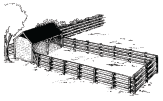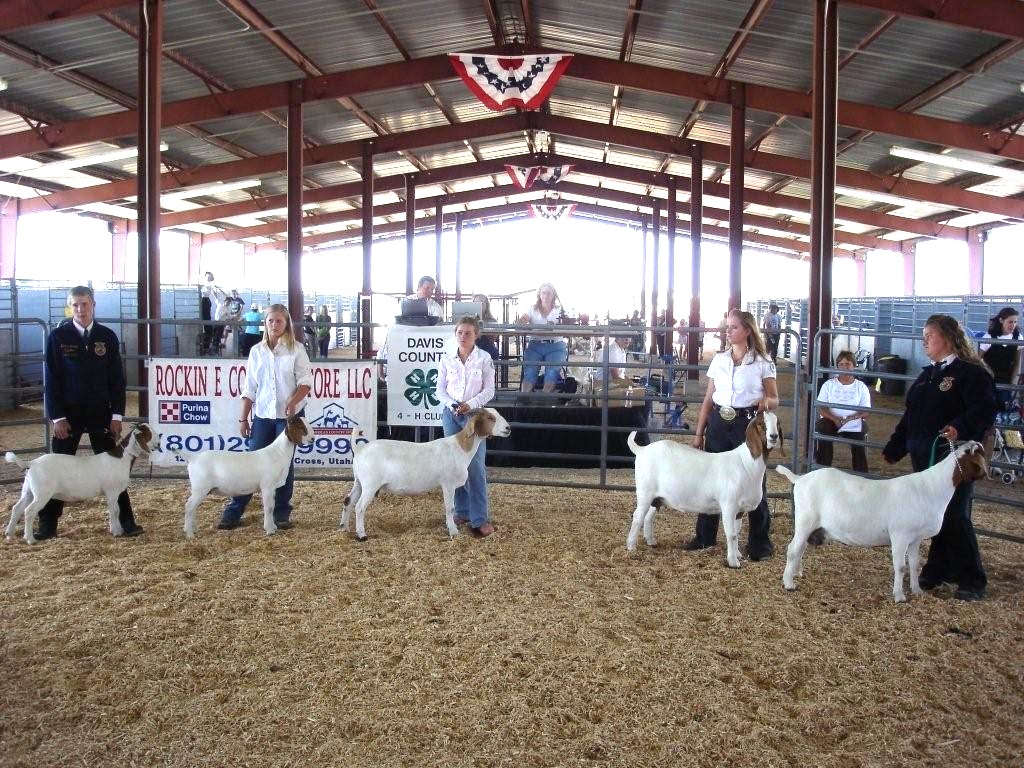First-Time Market Goat

Introduction
Congratulations on your decision to join one of the most hands-on 4-H activities out there! This fact sheet is designed for first-time goat projects to help prepare and guide you through some of the basic steps in working through your 4-H livestock project.
Preparation
Register for 4-H

Contact your local 4-H office to find out how to join a 4-H club and where to register for 4-H.
Read the Rules
Determine where you plan to show your animal and read the rules and requirements for your project, including information like:- Tagging dates.
- Ownership length requirements.
- Minimum and maximum weights.
- Show dates, check-in dates, weigh days.
- Rules related to the specific show.
Find a Mentor
Find a mentor who has shown goats before to help guide you through the process. This can be an older 4-H or Future Farmers of America (FFA) Fmember, a leader, or a community member who has shown in the past.
Develop a Budget for Common Expenses

It is important to understand where and how your money is working for you when it comes to raising 4-H project animals. Tracking your expenses and incomes will help you decide future management decisions like selection, housing, supplements, feed, and transportation. Some common areas to consider include the following.
- Purchase amount: Shop around and see what show goats in the area are selling for. There will be wide ranges of goat prices depending on quality, breeder, breed, etc. The important part of budgeting is having a price in mind that you can afford and then shopping around for animals that fit in that price range.
- Housing: Animals should be penned in areas with proper footing, ventilation, shade, and free from any objects that may cause harm. Additionally, build pens with materials that will keep your project animals in and predators out.
- Water: All show animals need access to fresh water. This is the most important factor in raising a show goat. Water buckets should be kept in the shade and cleaned out on a regular basis.

- Feed: Consult with your local feed store or 4-H group leader to learn more about goat nutrition. As a rule, growing show goats should eat approximately 4% of their body weight per day. As animals mature and growth slows down, that will decrease to 3% per day. They should also have access to a high-quality hay source.
- Vet care: While there usually are not many vet care expenses on a market animal, you should always budget several hundred dollars in case you must address an emergency.

- Routine preventative care: Remember you are raising an animal destined for food production, so there are withdrawal periods on medications that apply to your animal. Please read each label carefully and consult a veterinarian before any treatment. Common medications/vaccines to be aware of include wormer, CD/T boosters, and anything for scours or diarrhea.
- Supplies: To properly prepare and manage your animal for your desired show, consider the following must-haves.
- Clippers. Goats may need to be clipped uniformly 3/8 inch above the knees or hocks. Purchasing a set of clippers and blades is highly recommended, especially as show day approaches and the demand for communal/group supplies increases. Owning your own set of clippers and blades also ensures biosecurity and minimizes spreading disease.
- Stand. A stand secures the goat’s head to maintain control while grooming and prepping animals for show.

- Cleaning shampoo/Conditioning treatment. Washing and cleaning the goat before clipping preserves the life and sharpness of your clippers and blades by removing debris from the hair coat that may dull your blades. Once clipped, condition the animal regularly to maintain healthy skin and coat conditions.
- Halters. Using a halter made specifically for goats is a great tool to help train your animal how to walk and lead.

- Blankets (optional). While these items are not necessary to raise a 4-H market goat, they do provide added benefits and protection.
Select an Animal
- Contact a reputable breeder in your area. Ask kids in the community who have shown where they get their animals and what they look for in a breeder. Most breeders are willing to help with a feed program and progress reports throughout your project. There are also many online sale sources. Join some of the local livestock social media pages to find more options.
- Select an animal that will be the right size for your county fair. You will want your goat to be between 6–10 months of age when you show it and average 70–100 pounds. You will usually select your animal at around 8 weeks of age, and it should weigh around 25–40 pounds. Check your local rules to ensure you know the minimum weight requirement for fair weigh-in.
- Goats must be under 1 year of age and still have their milk teeth at the time of their final market show. Plan accordingly when selecting your animal.
Bring Your Animal Home

Housing
- Have a safe and secure pen set up, including clean water and feed. Make sure it has shelter from the sun, wind, rain, and snow.
Feed and Weight Gain
- Try to find out what the breeder has been feeding your animal, purchase the same food, or get a small quantity from the breeder to make a gradual shift to a food of your choice.
- Check with your local feed companies to see what food they have for your species of animal and how fresh and frequently they get it in stock.
- Pick a feed and stick with it! It can cause stomach upset if you are constantly switching feed. It can also decrease weight gain.
- A newly weaned goat should be on a creep feed or free choice until they hit about 55–70 pounds.
- Once they reach 70 pounds, you can switch them to a weighed feed regiment. You can also start an exercise program at this time.
- For increased weight gain, feed 3.5% to 4% of the goat’s body weight in dry matter.
- To maintain weight, feed 3% of body weight in dry matter.
- Split the feed quantity in half and feed one-half twice a day.
- Regularly weigh your animal and adjust the feed.
- Check with your local FFA chapter; they usually have summer weigh days.
- Your goat will need to be fed some hay along with their show grain every day. Hay is important for the rumen function; too much can cause what looks like a more bloated belly. Reducing the hay amount a of couple weeks before the fair can reduce that hay belly look.
Training
- Start halter-breaking your animal a few days after you bring it home (once it has settled in).
- Put the halter on your goat and tie it somewhere it can’t climb or get tangled, and let it get used to being tied up. Stay close in case it gets itself into trouble. Once the goat learns how to stand, tie it to a fence or something overhead with the goat’s head above its shoulders. This will help prepare the goat on how to hold its head in the show ring.
- Teach your goat to walk on a halter. Have another person walk behind the goat to help encourage it to walk.
- Once your goat knows how to walk, start teaching it how to brace. A brace is a forward-pushing motion from your goat that engages all its muscles.
- Teach it to tolerate you moving and adjusting its legs into a proper show stance. A finished goat can walk and then stand and brace without moving for 3–5 minutes at a time.
- Repetition and consistency are the keys to success with training goats.
- Be patient.
Health

- Deworm your animal when you first bring it home. Follow your local veterinarian’s advice for frequency, dosage, and type of wormer to use.
- Watch for any abnormal health concerns and contact a veterinarian immediately if you observe any of the following:
Diarrhea.
- Not eating or drinking.
- Respiratory symptoms, i.e., coughing or nasal and eye discharge.
- Lameness.
- Scabs.
- Hair loss.
- Goats are required to be either disbudded or have horns tipped for the show.
- Most male goats are disbudded at castration by the breeder or a veterinarian.
Photo Credits
The cover page pictures K. and K. Shaffer at the Box Elder County Showmanship Contest; the other photo was provided by Utah State University Extension.
References
- Faris, B. R. (2012, November). Market goat showmanship from start to finish [Fact sheet MF3064]. Kansas State University Agricultural Experiment Station and Cooperative Extension Service. https://extension.unl.edu/statewide/webster/MF3064.pdf
- Gosz, R. (2018, May 1). Meat goat showmanship [Fact sheet AFS-3864]. Oklahoma State University Extension. https://extension.okstate.edu/fact-sheets/meat-goat-showmanship.html
- Washington State University Extension. (n.d.). Training, grooming, and showing market goats [Fact sheet]. https://extension.wsu.edu/animalag/content/training-grooming-and-showing-market-goats/
April 2024
Utah State University Extension
Peer-reviewed fact sheet
Authors
Ashely T. Longmore, USU Extension Assistant Professor - Box Elder County
Cheyenne A. Reid, USU Extension Assistant Professor - Uintah County
Related Research


 Staff Resources
Staff Resources
